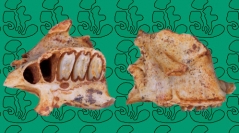

 Comptes Rendus Palevol
20 (28) - Pages 597-617
Comptes Rendus Palevol
20 (28) - Pages 597-617Pliocene occurrences of Prolagus Pomel, 1853 in central Europe represent anomalies out of the peri-Mediterranean area, at that time the core distribution of the genus. Though known for several decades, those materials never underwent a general revision. The detailed analysis and comparison of all available materials performed here revealed two phenotypic entities: 1) Prolagus bilobus Heller, 1936 (Gundersheim localities, Raciszyn 1), for which were defined additional diagnostic characters and ontogenetic patterns of variation (d3/p3 and mandible); and 2) Prolagus sp. (Beremend 26/39), probably a new species. All the available occurrences are dated to MN15b. The morphological trends towards the reduction of p3 entoconid and of enamel folding evidenced in Pliocene Prolagus of western Europe cannot be recognized in coeval central European forms. Evidently, P. bilobus and Prolagus sp. do not pertain to the western European clade, whose separation is known since the early late Miocene. We hypothesize that at least P. bilobus originated from a dispersal of Prolagus from south-eastern regions of Europe rather than from an autochthonous speciation of isolated populations left as a relict after the southward displacement of Prolagus distribution area. The dispersal is likely to be related to the Pliocene global environmental changes during which extensive faunal rearrangements took place in Europe, in particular to those near the early/late Pliocene boundary.
Prolagidae, Prolagus bilobus, Gundersheim, Raciszyn 1, Beremend, palaeobiogeography